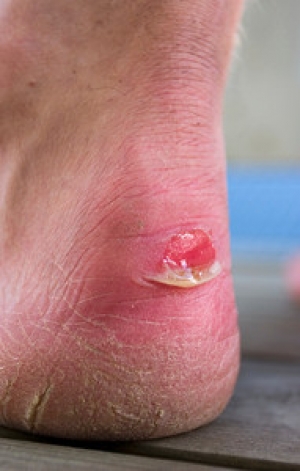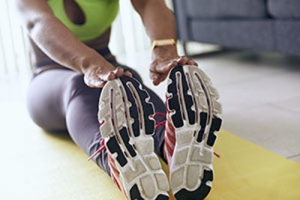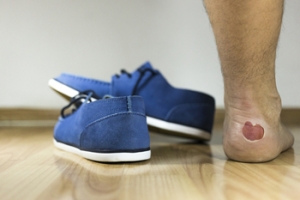Connect With Us
Featured Articles
Super User
What Causes a Blister to Develop?
 If you frequently run or wear shoes that are too tight, you may develop a blister. This may be a result of excess friction that occurs on a portion of the skin. A blister is defined as a small bubble that is filled with clear liquid and may naturally drain when the affected area of skin has healed. The top layer of the skin may become raw and painful, and the body’s natural defense mechanism may be to develop a blister, which will protect the skin that has been damaged. There may be additional reasons for blisters to develop, which may include allergic reactions, sunburns, or medical conditions such as impetigo. If a blister should become infected, it may appear to be yellow or green, in addition to possibly causing pain and discomfort. If you have a blister on your foot that will not heal, it is suggested that you speak to a podiatrist.
If you frequently run or wear shoes that are too tight, you may develop a blister. This may be a result of excess friction that occurs on a portion of the skin. A blister is defined as a small bubble that is filled with clear liquid and may naturally drain when the affected area of skin has healed. The top layer of the skin may become raw and painful, and the body’s natural defense mechanism may be to develop a blister, which will protect the skin that has been damaged. There may be additional reasons for blisters to develop, which may include allergic reactions, sunburns, or medical conditions such as impetigo. If a blister should become infected, it may appear to be yellow or green, in addition to possibly causing pain and discomfort. If you have a blister on your foot that will not heal, it is suggested that you speak to a podiatrist.
Blisters are prone to making everyday activities extremely uncomfortable. If your feet are hurting, contact Scott Matthews, DPM, MD of Salem Foot Care . Our doctor can provide the care you need to keep you pain-free and on your feet.
Foot Blisters
Foot blisters develop as a result of constantly wearing tight or ill-fitting footwear. This happens due to the constant rubbing from the shoe, which can often lead to pain.
What Are Foot Blisters?
A foot blister is a small fluid-filled pocket that forms on the upper-most layer of the skin. Blisters are filled with clear fluid and can lead to blood drainage or pus if the area becomes infected.
How Do Blisters Form?
Blisters on the feet are often the result of constant friction of skin and material, usually by shoe rubbing. Walking in sandals, boots, or shoes that don’t fit properly for long periods of time can result in a blister. Having consistent foot moisture and humidity can easily lead to blister formation.
Prevention & Treatment
It is important to properly care for the affected area in order to prevent infection and ease the pain. Do not lance the blister and use a Band-Aid to provide pain relief. Also, be sure to keep your feet dry and wear proper fitting shoes. If you see blood or pus in a blister, seek assistance from a podiatrist.
If you have any questions, please feel free to contact our office located in Wikesboro, NC . We offer the newest diagnostic and treatment technologies for all your foot care needs.
Possible Foot Conditions May Develop from Standing
 If you work on your feet and stand for the majority of the day, it is important to take care of your feet by choosing the correct shoes. They should have adequate arch support and the heel should be two inches or lower. There are several people who stand in one position for extended periods of time, and this may diminish blood flow to the muscles. Additionally, there may be other conditions that can develop from standing while you’re working. These may include swollen feet, plantar fasciitis, or Achilles tendinitis. It may be beneficial to take breaks which allows you to sit down and rest your feet as frequently as possible. Anti-fatigue mats may be helpful in providing extra support and cushioning that the feet need, and many people find it advantageous to wear cotton socks which are more breathable than nylons. If you would like additional information about how to take care of your feet while working, please speak to a podiatrist who can properly assist you.
If you work on your feet and stand for the majority of the day, it is important to take care of your feet by choosing the correct shoes. They should have adequate arch support and the heel should be two inches or lower. There are several people who stand in one position for extended periods of time, and this may diminish blood flow to the muscles. Additionally, there may be other conditions that can develop from standing while you’re working. These may include swollen feet, plantar fasciitis, or Achilles tendinitis. It may be beneficial to take breaks which allows you to sit down and rest your feet as frequently as possible. Anti-fatigue mats may be helpful in providing extra support and cushioning that the feet need, and many people find it advantageous to wear cotton socks which are more breathable than nylons. If you would like additional information about how to take care of your feet while working, please speak to a podiatrist who can properly assist you.
While working on the feet, it is important to take the proper care of them. For more information about working on your feet, contact Scott Matthews, DPM, MD from Salem Foot Care . Our doctor will treat your foot and ankle needs.
Working on Your Feet
Standing on your feet for long periods of time can cause stress and pain in your feet. Your whole body may experience change in terms of posture, back pain, bunions, callouses and or plantar warts. There are ways to avoid these conditions with proper foot care, smart choices and correct posture.
Positive Changes
Negative heeled shoe – Choosing this shoe type places the heel slightly lower than the ball of the foot. These are great for overall foot health. Find shoes that fit you correctly.
Go barefoot – Our feet were not designed to be enclosed for all hours of the day. Try to periodically expose your feet to air.
Eliminate Pain
Foot Exercises – Performing simple exercises, incorporating yoga and doing stretches are beneficial. This will allow increased blood flow to the area and muscles of the foot.
Achilles tendon – Stretching the foot out flat on the floor will relax the calf muscles and tendon. These exercises can be performed almost anywhere. Make sure you add these exercises to your daily regimen.
With a little bit of this information and knowing more about foot health, you will notice changes. Foot stretches and proper footwear will help with pain and prevent further issues.
If you have any questions please feel free to contact our office located in Wikesboro, NC . We offer the newest diagnostic and treatment technologies for all your foot and ankle needs.
Many Types of Foot Surgery
 Many patients have had their various foot conditions successfully treated, but for some, foot surgery may be necessary as a possible option for relief. There are several types of foot issues that can benefit from having foot surgery performed, and these may include bunions, hammertoes, and arthritis. The surgery that may help to correct bunions is referred to as a bunionectomy. The benefits of having this type of surgery performed may include wearing shoes that are closed, and performing daily activities with ease. Arthritis may be helped by having fusion surgery performed, and this may help to join the bones of the foot together which may eliminate painful rubbing. Hammertoe can be helped by removing bones, tendons, or joints which may help to straighten out the toe. If the plantar fascia is inflamed which may lead to plantar fasciitis, heel surgery may be a viable option to consider. If you would like additional information about foot surgery, please consult with a podiatrist who can answer any questions you may have.
Many patients have had their various foot conditions successfully treated, but for some, foot surgery may be necessary as a possible option for relief. There are several types of foot issues that can benefit from having foot surgery performed, and these may include bunions, hammertoes, and arthritis. The surgery that may help to correct bunions is referred to as a bunionectomy. The benefits of having this type of surgery performed may include wearing shoes that are closed, and performing daily activities with ease. Arthritis may be helped by having fusion surgery performed, and this may help to join the bones of the foot together which may eliminate painful rubbing. Hammertoe can be helped by removing bones, tendons, or joints which may help to straighten out the toe. If the plantar fascia is inflamed which may lead to plantar fasciitis, heel surgery may be a viable option to consider. If you would like additional information about foot surgery, please consult with a podiatrist who can answer any questions you may have.
Foot surgery is sometimes necessary to treat a foot ailment. To learn more, contact Scott Matthews, DPM, MD of Salem Foot Care . Our doctor will assist you with all of your foot and ankle needs.
When Is Surgery Necessary?
Foot and ankle surgery is generally reserved for cases in which less invasive, conservative procedures have failed to alleviate the problem. Some of the cases in which surgery may be necessary include:
- Removing foot deformities like bunions and bone spurs
- Severe arthritis that has caused bone issues
- Cosmetic reconstruction
What Types of Surgery Are There?
The type of surgery you receive will depend on the nature of the problem you have. Some of the possible surgeries include:
- Bunionectomy for painful bunions
- Surgical fusion for realignment of bones
- Neuropathy decompression surgery to treat nerve damage
Benefits of Surgery
Although surgery is usually a last resort, it can provide more complete pain relief compared to non-surgical methods and may allow you to finally resume full activity.
Surgical techniques have also become increasingly sophisticated. Techniques like endoscopic surgery allow for smaller incisions and faster recovery times.
If you have any questions please feel free to contact our office located in Wikesboro, NC . We offer the newest diagnostic and treatment technologies for all your foot and ankle needs.
How to Prevent a Corn from Developing
 Corns are generally a common ailment where many people seek the advice of a podiatrist. Pressure is typically the cause of most corns, and this may be a result of pressure the toe endures. If shoes or socks are worn that are too tight, the toes may rub against the material, and a corn may develop. Some patients have hammertoes, in which the toes are bent downward, and a corn may form on top of the toe in the area where the bend occurs. There are preventive measures that can be implemented which may be successful in preventing corns. These may include wearing shoes that have adequate room for the toes to move about, and using foam pads which may protect the skin between the toes. If you are experiencing pain that may be caused by a corn, it is suggested that you speak to a podiatrist who can properly guide you in maintaining and preventing corns.
Corns are generally a common ailment where many people seek the advice of a podiatrist. Pressure is typically the cause of most corns, and this may be a result of pressure the toe endures. If shoes or socks are worn that are too tight, the toes may rub against the material, and a corn may develop. Some patients have hammertoes, in which the toes are bent downward, and a corn may form on top of the toe in the area where the bend occurs. There are preventive measures that can be implemented which may be successful in preventing corns. These may include wearing shoes that have adequate room for the toes to move about, and using foam pads which may protect the skin between the toes. If you are experiencing pain that may be caused by a corn, it is suggested that you speak to a podiatrist who can properly guide you in maintaining and preventing corns.
If you have any concerns regarding your feet and ankles, contact Scott Matthews, DPM, MD of Salem Foot Care . Our doctor will treat your foot and ankle needs.
Corns: What Are They? and How Do You Get Rid of Them?
Corns can be described as areas of the skin that have thickened to the point of becoming painful or irritating. They are often layers and layers of the skin that have become dry and rough, and are normally smaller than calluses.
Ways to Prevent Corns
There are many ways to get rid of painful corns such as wearing:
- Well-fitting socks
- Comfortable shoes that are not tight around your foot
- Shoes that offer support
Treating Corns
Treatment of corns involves removing the dead skin that has built up in the specific area of the foot. Consult with Our doctor to determine the best treatment option for your case of corns.
If you have any questions please feel free to contact our office located in Wikesboro, NC . We offer the newest diagnostic and treatment technologies for all your foot and ankle needs.
Why Preventing Running Injuries Is Important
 Research has shown that approximately half of all injuries incurred by runners may be prevented by paying attention to your body in addition to taking the proper precautions by stretching the feet and ankles thoroughly before embarking on a run. A condition that is known as Achilles tendinitis may occur as a result of tight calf muscles, and the pain and discomfort this injury may bring may be avoided by building strength in the Achilles tendon and surrounding areas. Additionally, many patients experience an uncomfortable condition that is referred to as plantar fasciitis, and this is characterized by severe pain in the heel area of the foot. This may be prevented by wearing shoes that fit properly and have adequate arch support. If you would like additional information on how to prevent painful running injuries, it is advised to consult with a podiatrist who can properly guide you.
Research has shown that approximately half of all injuries incurred by runners may be prevented by paying attention to your body in addition to taking the proper precautions by stretching the feet and ankles thoroughly before embarking on a run. A condition that is known as Achilles tendinitis may occur as a result of tight calf muscles, and the pain and discomfort this injury may bring may be avoided by building strength in the Achilles tendon and surrounding areas. Additionally, many patients experience an uncomfortable condition that is referred to as plantar fasciitis, and this is characterized by severe pain in the heel area of the foot. This may be prevented by wearing shoes that fit properly and have adequate arch support. If you would like additional information on how to prevent painful running injuries, it is advised to consult with a podiatrist who can properly guide you.
Exercising your feet regularly with the proper foot wear is a great way to prevent injuries. If you have any concerns about your feet, contact Scott Matthews, DPM, MD of Salem Foot Care . Our doctor will treat your foot and ankle needs.
How to Prevent Running Injuries
Many common running injuries are caused by overuse and overtraining. When the back of the kneecap starts wearing out and starts causing pain in your knee, this is commonly referred to as runner’s knee. Runner’s knee is a decrease in strength in your quadriceps and can occur if you’re not wearing properly fitted or supporting shoes. To prevent runner’s knee, focusing on hip strengthening is a good idea, as well as strengthening your quads to keep the kneecaps aligned.
What Are Some Causes of Running Injuries?
- One cause of a common running injury is called iliotibial band syndrome.
- Plantar fasciitis is also another common injury.
- Stress fractures can occur from overtraining, lack of calcium, or even your running style.
Best Ways to Prevent Running Injuries
- Wear footwear that fits properly and suits your running needs.
- Running shoes are the only protective gear that runners have to safeguard them from injury.
- Make a training schedule. Adding strengthening exercises as well as regular stretching can help keep you strong and limber and can lessen the possibility of injuries.
- Stretching keeps muscles limber; this will help you gain better flexibility.
If you have any questions please feel free to contact our office located in Wikesboro, NC . We offer the newest diagnostic and treatment technologies for all your foot and ankle needs.
Preventing Blisters While You Travel
 One of the ways to have a more enjoyable travel experience is to include comfortable shoes in your suitcase. If you are planning on spending most of the day walking or exploring, it’s important to choose shoes that fit properly. Many patients may experience the uncomfortable condition that is known as blisters, and this may hinder any walking plans you may have. When purchasing new shoes, there may be a breaking-in period that is needed, and this may be beneficial by doing this before the trip begins. Many people have worn their new shoes with wool socks, and this may be helpful in softening the interior of the shoe. If a painful blister should occur, it may be advantageous to bring a medical kit, which may include different sizes and types of bandages, and an additional pair of socks. It is advised to contact a podiatrist if you would like additional information on the prevention or treatment of blisters.
One of the ways to have a more enjoyable travel experience is to include comfortable shoes in your suitcase. If you are planning on spending most of the day walking or exploring, it’s important to choose shoes that fit properly. Many patients may experience the uncomfortable condition that is known as blisters, and this may hinder any walking plans you may have. When purchasing new shoes, there may be a breaking-in period that is needed, and this may be beneficial by doing this before the trip begins. Many people have worn their new shoes with wool socks, and this may be helpful in softening the interior of the shoe. If a painful blister should occur, it may be advantageous to bring a medical kit, which may include different sizes and types of bandages, and an additional pair of socks. It is advised to contact a podiatrist if you would like additional information on the prevention or treatment of blisters.
Blisters are prone to making everyday activities extremely uncomfortable. If your feet are hurting, contact Scott Matthews, DPM, MD of Salem Foot Care . Our doctor can provide the care you need to keep you pain-free and on your feet.
Foot Blisters
Foot blisters develop as a result of constantly wearing tight or ill-fitting footwear. This happens due to the constant rubbing from the shoe, which can often lead to pain.
What Are Foot Blisters?
A foot blister is a small fluid-filled pocket that forms on the upper-most layer of the skin. Blisters are filled with clear fluid and can lead to blood drainage or pus if the area becomes infected.
How Do Blisters Form?
Blisters on the feet are often the result of constant friction of skin and material, usually by shoe rubbing. Walking in sandals, boots, or shoes that don’t fit properly for long periods of time can result in a blister. Having consistent foot moisture and humidity can easily lead to blister formation.
Prevention & Treatment
It is important to properly care for the affected area in order to prevent infection and ease the pain. Do not lance the blister and use a Band-Aid to provide pain relief. Also, be sure to keep your feet dry and wear proper fitting shoes. If you see blood or pus in a blister, seek assistance from a podiatrist.
If you have any questions, please feel free to contact our office located in Wikesboro, NC . We offer the newest diagnostic and treatment technologies for all your foot care needs.
Read more about BlistersSteroid Injections May Possibly Treat Arthritis
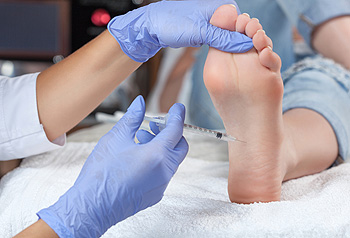 If you are experiencing pain, stiffness, or swelling in the joints of your feet, you may have what is known as arthritis. A common area of the foot where arthritis may appear are the toes, and severe pain and discomfort may be felt while lifting the toes to walk. You may notice a permanent bend in the joints of the toes, and this may make it difficult for the foot to lie flat on the floor. Some patients notice a bump developing on top of the toes, and this may possibly result from the joints rubbing together. Additionally, the toenails may separate from the nail bed, or pain may be felt in the rest of the foot. Possible treatment options can include injecting steroids, which may aid in reducing any inflammation that may be present. Having surgery performed, which may be helpful in reshaping the bones in the feet may be an additional option. It is advised to speak to a podiatrist who can assist you in determining which treatment is best for you.
If you are experiencing pain, stiffness, or swelling in the joints of your feet, you may have what is known as arthritis. A common area of the foot where arthritis may appear are the toes, and severe pain and discomfort may be felt while lifting the toes to walk. You may notice a permanent bend in the joints of the toes, and this may make it difficult for the foot to lie flat on the floor. Some patients notice a bump developing on top of the toes, and this may possibly result from the joints rubbing together. Additionally, the toenails may separate from the nail bed, or pain may be felt in the rest of the foot. Possible treatment options can include injecting steroids, which may aid in reducing any inflammation that may be present. Having surgery performed, which may be helpful in reshaping the bones in the feet may be an additional option. It is advised to speak to a podiatrist who can assist you in determining which treatment is best for you.
Arthritis can be a difficult condition to live with. If you are seeking treatment, contact Scott Matthews, DPM, MD from Salem Foot Care . Our doctor can provide the care you need to keep you pain-free and on your feet.
Arthritic Foot Care
Arthritis is a term that is commonly used to describe joint pain. The condition itself can occur to anyone of any age, race, or gender, and there are over 100 types of it. Nevertheless, arthritis is more commonly found in women compared to men, and it is also more prevalent in those who are overweight. The causes of arthritis vary depending on which type of arthritis you have. Osteoarthritis for example, is often caused by injury, while rheumatoid arthritis is caused by a misdirected immune system.
Symptoms
- Swelling
- Pain
- Stiffness
- Decreased Range of Motion
Arthritic symptoms range in severity, and they may come and go. Some symptoms stay the same for several years but could potentially get worse with time. Severe cases of arthritis can prevent its sufferers from performing daily activities and make walking difficult.
Risk Factors
- Occupation – Occupations requiring repetitive knee movements have been linked to osteoarthritis
- Obesity – Excess weight can contribute to osteoarthritis development
- Infection – Microbial agents can infect the joints and trigger arthritis
- Joint Injuries – Damage to joints may lead to osteoarthritis
- Age – Risk increases with age
- Gender –Most types are more common in women
- Genetics – Arthritis can be hereditary
If you suspect your arthritis is affecting your feet, it is crucial that you see a podiatrist immediately. Your doctor will be able to address your specific case and help you decide which treatment method is best for you.
If you have any questions, please feel free to contact our office located in Wikesboro, NC . We offer the newest diagnostic and treatment technologies for all your foot care needs.
Is Foot Therapy Effective?
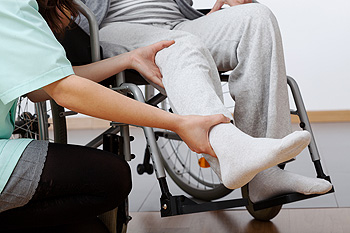 Many people have experienced foot and ankle injuries and may be familiar with physical therapy as a form of positive foot therapy. It may contribute in providing the desired relief, which may be needed from uncomfortable foot conditions that may include plantar fasciitis or foot and ankle fractures. This type of therapy may be conducive in restoring joint mobility, much needed muscle strength, in addition to improvements in walking. These types of injuries may originate from overuse of the muscles and tendons in the feet and ankles. Additionally, foot therapy may be useful in recovering from foot or ankle surgery. If you have endured a serious injury to your foot, ankle, or surrounding areas, it is advised to seek the counsel of a podiatrist who can recommend the best form of therapy for you.
Many people have experienced foot and ankle injuries and may be familiar with physical therapy as a form of positive foot therapy. It may contribute in providing the desired relief, which may be needed from uncomfortable foot conditions that may include plantar fasciitis or foot and ankle fractures. This type of therapy may be conducive in restoring joint mobility, much needed muscle strength, in addition to improvements in walking. These types of injuries may originate from overuse of the muscles and tendons in the feet and ankles. Additionally, foot therapy may be useful in recovering from foot or ankle surgery. If you have endured a serious injury to your foot, ankle, or surrounding areas, it is advised to seek the counsel of a podiatrist who can recommend the best form of therapy for you.
Foot therapy is often necessary for those recovering from either foot deformities or foot injuries. If you have concerns regarding therapy, Scott Matthews, DPM, MD of Salem Foot Care . Our doctor can provide the care you need to keep you pain-free and on your feet.
Most Common Injuries
People who are active or athletes are prone to a variety of injuries. Therefore, it is often important to take part in physical therapy in order to quickly get back on the right track.
What to Do When Injured
Physical Therapy – This specialized treatment will focus on the affected area, speeding up recovery and the overall healing process. It is a proven method that has helped millions of people return from any injury.
During physical therapy you will undergo regimented training to get back into full form. Training is often very difficult, especially at first when the foot feels weak. Physical therapy often involves:
Basic stretching and twisting exercises – getting the feet’s mobility and flexibility up.
Massaging – the therapist will massage the injured area in order to activate the muscles and relax them.
Strengthening Exercises – this allows the muscles in the affected area to regain their full strength, a vital step towards full recovery.
If you have any questions please feel free to contact our office located in Wikesboro, NC . We offer the newest diagnostic tools and technology to treat your foot and ankle needs.
Foot Therapy for Sports Injuries
Whether in practice or in the game, athletes put their bodies through great stress. Some sports demand more from the body than others. However, every sport has an element of inorganic movement or unnatural motion. For example, in softball, a pitcher winds up and flings her body with an incredible amount of dexterity in order to get the most ideal velocity out of her pitches. This motion, incredibly taxing on the body, can cause serious injury.
One of the most common issues of athletic injuries happens in the feet. If it’s a damaging fracture that leaves the athlete sidelined or just a simple turf toe, foot injuries can still be very frustrating and painful. Regardless of the sport, athletes still require use of their feet in some fashion. This is why foot therapy is extremely vital for getting athletes back on the right track to return to the field.
No matter the injury, the best way to speed up the recovery period is to receive physical therapy. Physical therapy has proven to work for millions of people. Professional physical therapists are specifically trained to help people return to proper form from any injury.
During physical therapy, you will go through organized training in order to get back into form. Sometimes training can be quite difficult, especially in the beginning when there is more pain and the foot feels awkward. To alleviate this, you will do basic twisting and stretching exercises in order to get flexibility and foot mobility back up. The therapist will also massage the injured area to activate and relax muscles. Over time you will eventually move up to strengthening exercises, designed specifically so that the injured area is exercised.
Foot therapy for sports is a modern science miracle. Unlike other treatments that may employ the use of fancy chemicals and terminology, physical therapy is an evidence-based practice that offers the same benefits. Due to huge advancements in the knowledge of muscles and joints, doctors can turn catastrophic injuries around so that athletes can return to the game once more.
The Importance of Choosing the Right Type of Shoe
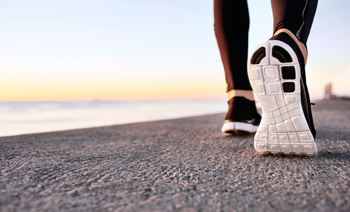 People who enjoy the sport of running understand the importance of choosing the right type of running shoe. This may aid in keeping the muscles and joints healthy and may maximize the benefits of running. The feet have different functions when walking and running are practiced and it’s important to choose the correct shoe. Running is a high impact exercise and the feet will generally absorb three times the weight of the body. People who enjoy walking will notice the body’s weight is much more evenly distributed between the feet and the legs and may benefit by choosing shoes with adequate arch support. When deciding on a running shoe, you may notice the sole is stiffer and there is more cushioning in the heel area. Additionally, they tend to be generally lighter in weight than walking shoes, which may aid the runner to have faster mobility. If you would like additional information about the differences between walking and running shoes, it is suggested to speak with a podiatrist.
People who enjoy the sport of running understand the importance of choosing the right type of running shoe. This may aid in keeping the muscles and joints healthy and may maximize the benefits of running. The feet have different functions when walking and running are practiced and it’s important to choose the correct shoe. Running is a high impact exercise and the feet will generally absorb three times the weight of the body. People who enjoy walking will notice the body’s weight is much more evenly distributed between the feet and the legs and may benefit by choosing shoes with adequate arch support. When deciding on a running shoe, you may notice the sole is stiffer and there is more cushioning in the heel area. Additionally, they tend to be generally lighter in weight than walking shoes, which may aid the runner to have faster mobility. If you would like additional information about the differences between walking and running shoes, it is suggested to speak with a podiatrist.
For more information about walking shoes versus running shoes, consult with Scott Matthews, DPM, MD from Salem Foot Care . Our doctor can measure your feet to determine what your needs are and help you find an appropriate pair of footwear.
Foot Health: The Differences between Walking & Running Shoes
There are great ways to stay in shape: running and walking are two great exercises to a healthy lifestyle. It is important to know that running shoes and walking shoes are not interchangeable. There is a key difference on how the feet hit the ground when someone is running or walking. This is why one should be aware that a shoe is designed differently for each activity.
You may be asking yourself what the real differences are between walking and running shoes and the answers may shock you.
Differences
Walking doesn’t involve as much stress or impact on the feet as running does. However, this doesn’t mean that you should be any less prepared. When you’re walking, you land on your heels and have your foot roll forward. This rolling motion requires additional support to the feet.
Flexibility – Walking shoes are designed to have soft, flexible soles. This allows the walker to push off easily with each step.
If you have any questions, please feel free to contact our office located in Wikesboro, NC . We offer the newest diagnostic and treatment technologies for all your foot care needs.
